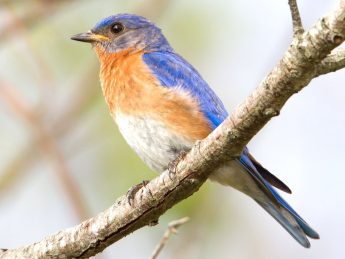Introduction
Quick Navigation
Bluebirds like other birds See also[TEXT]reference[LINK] are classified in kingdom Animalia, phylum Chordata, and class Aves. Bluebirds however, belong to order Passeriformes, family Turdidae, and genera Sialia. There are different species of bluebirds such as Sialia sialis, commonly known as Eastern bluebird, Sialia Mexicana commonly known as Western bluebird, and Sialia currucoides, commonly known as Mountain bluebird. Bluebirds are native to North America and Central America. They have predominant yellow color on their backsides while their undersides are brownish. These color patterns vary largely from one species to another. To many people, bluebirds symbolize joy and goodness. There is hardly any observable difference between male and female bluebirds.
Diets and Lifestyle of Bluebirds
Bluebirds are mainly insect eaters; insects make up to two-thirds of bluebirds’ feeds. They enjoy preying on spiders, grasshoppers, beetles, ants, crickets, caterpillars, grains of grasses in their habitats. Although they do not visit feeders as often, bluebirds enjoy eating mealworms, sue dough, and eggshell bits. Female bluebirds particularly enjoy eating eggshells from where they derive a lot of calcium during the periods. Bluebirds are no fans of seeds and grains, and hence, they do not eat cracked corns, crushed nuts unlike some other species of birds.
Bluebirds prefer to live in meadows with scattered trees. This type of habitat serves two main purposes: first, it enables the birds to forage for their favorite foods; and second, it provides good nesting sites for the birds as they locate tree cavities that are suitable for nesting. Usually, male bluebird locates good nesting locations, and then sings to attract a female mate to that location. It is the female bluebird that builds neat, usually cup-shaped nest from pine trees and grasses. Building a nest may take five days or three weeks. After mating, adult female bluebird lays one egg every morning in the nest she has prepared. The eggs may be up to six in number, after which they are incubated for about 13 days. The eggs begin to hatch after this period. Either parent brings food to baby bluebirds until they are mature enough to do foraging. They are flocking birds.
How to Attract Bluebirds
Bluebirds are quite easy to attract although they prefer to stay in the open meadow where they can freely carry on their own activities. However, they can somewhat be manipulated, by attracting them probably to backyard or elsewhere, usually by creating a scenario similar to where they like to stay in. The following guidelines may be adopted in order attract bluebird.
The following guidelines may be adopted in order to attract bluebirds:
Open up a large area of meadow; this should normally include scattered trees where bluebirds can nest.
Cultivate native plants in the meadow area.
Leave the meadow alone. This will facilitate bluebirds being attracted to the area.
Ensure regular supply of water to the open space.
Do not apply chemicals to the meadow; chemicals are known to be repellants to many bird species.
Avoid roaming cats in the open space. Roaming cats tend to scare bluebirds, and may flee from the area altogether.
Offer mealworms, suet dough, sunflower chips, and bark butter bits. Mealworms should comprise potato, carrot, apple, or banana peel as moisturizers.
Locate nest boxes/houses in Sunniest, most open area, usually far from human residence.
Factors to Consider in Attracting Bluebirds
Choose a suitable location. Most people have the mentality that attracting bluebirds simply has to do with putting out nest boxes with food supplies. This may be true for other bird species but not for bluebirds. Attracting a huge flock of bluebirds requires choosing a large open space of green meadow, preferably with scatter tree stands, telephone lines, and posts that can provide shade and perches to bluebirds. This is far more preferable than mounting numerous nests in wild, forested locations as bluebirds do not like nesting in such locations.
Be sure to site multiple nest boxes reasonably apart from one another. Standard specification is 200 yards separation. There should be no direct line of sight between one nest box and another. Someone aiming at attracting bluebirds should bear in mind that the birds exhibit territoriality.
Choose a proper nest box. Suitable nest box for bluebirds are those not painted at all or painted on the outside only with light color that does not retain heat, and also ensures good ventilation.
Species of Bluebirds
Eastern Bluebird. This species of bluebird is known scientifically as Sialia sialis. It is native to North America where it dwells in woodlands, areas cultivated to fruits, and farmlands. It is a thrush with brilliant blue color on its backsides and head.
Western Bluebird. Its scientific name is Sialia mexicana. Memebers of this species are native to the western Rocky Mountains in Canada and Mexico. They usually go to winter in brushes, deserts, farms, and forests. They mostly keep single mates for a lifetime.
Mountain Bluebird. Members of this species occur in western Rocky Mountain of North America. Their scientific name is Sialia currucoides. They are small, migratory birds, otherwise known as arctic bluebirds.
Threats to Bluebird Existence
Apart from humans, a prominent threat to the bluebird population is the white sparrow or English sparrow which was introduced to North America hundreds of years ago. The white sparrow often visit the nests of bluebirds, scare adult bluebirds away and kill bluebird hatchlings or starve hatchlings to death. The white sparrow also pecks on unhatched bluebird eggs and kill the babies. It is also not unusual to find the white sparrow attack and kill an adult female bluebird while sitting right on her eggs. Humans on the other hand have negatively impacted the population of bluebirds across the world. This occurs by way of expansion of residential and commercial infrastructures into their natural habitats. The original dwelling units of these birds have been destroyed in many places resulting from human activities such as logging, construction, and modern tourism. Also, these birds in their different species have been scared away from their places of nativity as a result of industrial, commercial, and agricultural emissions that are completely strange to them.
Conclusion
Bluebirds are wonderful but territorial birds. Attracting them requires a lot of care and monitoring if the effort will be successful. Notwithstanding, it is not impossible, and the outcome can be very exciting.

